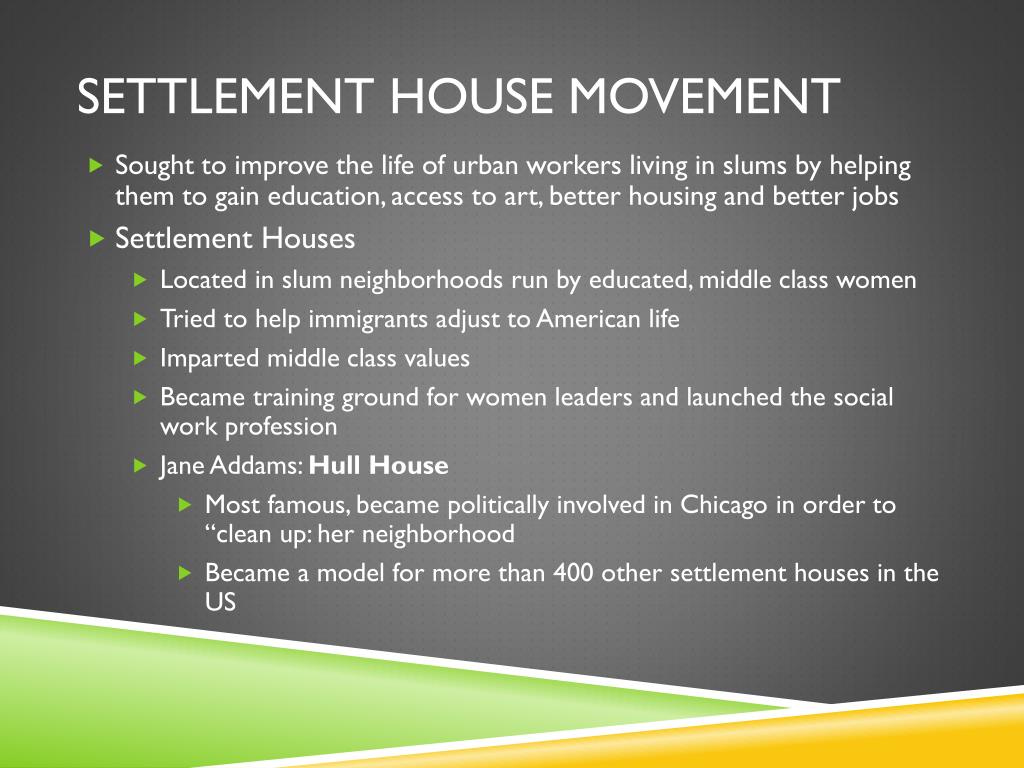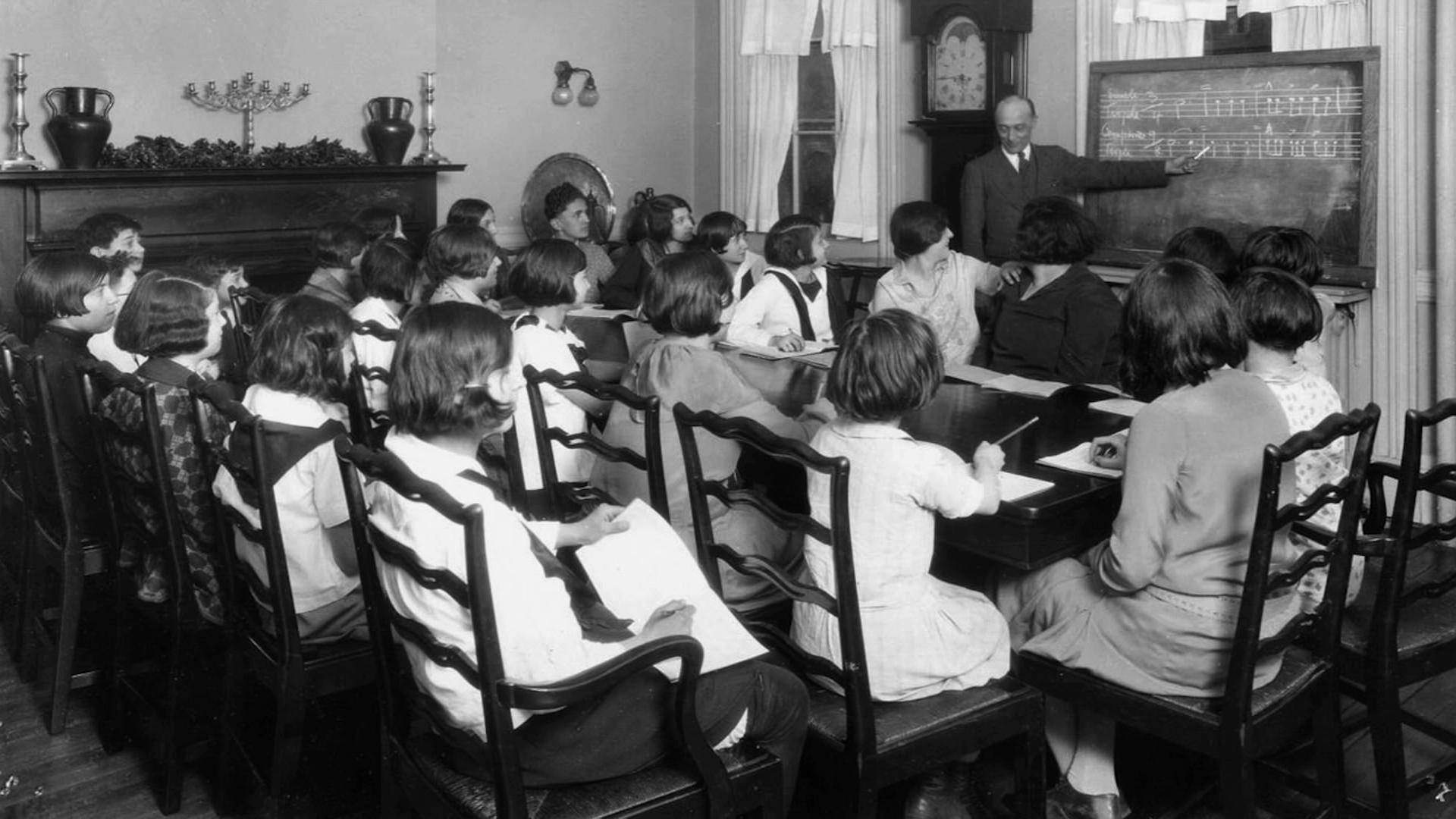Table Of Content

The following pages, based on research by Albert J. Kennedy summarize the specific ways in which settlements enriched or improved neighborhood life during the first sixty years. Sometimes they were leaders or participants in social causes in cooperation with others. Through the decades one can see many goals accomplished as certain activities disappear from the agenda. In many cases as with kindergartens, playgrounds, adult classes, sanitation, workmans’ compensation, mothers’ pensions, it is because these have become public responsibilities. Meanwhile, funds from the War on Poverty also went to settlements in relatively massive amounts. By 1965 neighborhood centers nationally were receiving from public funds a total equal to what they received from United Ways.
Personal account
In the United States the focus was also on city slums and the amelioration of wretched living conditions. The idea of “settling in” to learn as well as to help was eagerly embraced by a variety of caring groups. Sponsors included women’s colleges, theological seminaries, college Christian associations, churches, and the Ethical Culture Society.
Living in Glendale, California [Insider's Guide]
Raised money for relief; worked to make relief administration more flexible and humane; testified for unemployment legislation before municipal, state and federal committees ( ). Made national study under chairmanship of Helen Hall, documenting signs of coming catastrophe, and published findings in Studies in Unemployment and popular version Some Folks Won’t Work, providing base for important Congressional testimony. To save content items to your account,please confirm that you agree to abide by our usage policies.If this is the first time you use this feature, you will be asked to authorise Cambridge Core to connect with your account.Find out more about saving content to Dropbox. Encyclopedia.com gives you the ability to cite reference entries and articles according to common styles from the Modern Language Association (MLA), The Chicago Manual of Style, and the American Psychological Association (APA). Interiors can contain extensive hardwood paneling, grand fireplaces, and sweepingly elegant staircases.
Access options
Israel approves plans for thousands of illegal settlement homes - Al Jazeera English
Israel approves plans for thousands of illegal settlement homes.
Posted: Mon, 26 Jun 2023 07:00:00 GMT [source]
Seven new little theaters established in NY; children’s theaters, puppet and marionette theaters, tournaments of plays, city-wide festivals (1922 ff). High point of little theater companies and settlement stages, foreign-language dramatic and operatic groups, city-wide tournaments and festivals and open-air theater in NY. Founded 43 music schools and departments by 1916 and 83 more by 1926, leading to establishment of national office, publications, research and training in social music (1928). Addams incorporated a large number of environmental reforms in her agenda for Hull House.
Educational Equality & Title IX:
Settlement houses still exist, although they have become more specialized. Some of their services—providing libraries and kindergartens, for example—became the responsibility of municipal and state governments. The term "neighborhood center" (or in British English, neighbourhood centre) is often used today for similar institutions, as the early tradition of "residents" settling in the neighborhood has given way to professionalized social work. The modern version of this style has settled into a somewhat less showy form. Roofs are commonly steeply raked, multi-level, and intersecting with windows set into their triangular front-facing gables.

It saw government as the creation of society and as the instrument through which the good life could be brought within reach of all. If public baths or a playground or a citizenship class proved useful in one neighborhood, surely it was something which should be made available to all neighborhoods. The function of the settlement, and of city and national federations, was to interpret the significance of such public social programs and to push for their wider provision on the appropriate city, state or national level. The American settlement movement looked at all human life as precious, and saw it as interrelated–from person to family to neighborhood to city to nation. It saw the nation as indivisible and the settlements as the “distant early warning stations” which would inform the wider society of symptoms of social illness from which none would be immune. Rather than dispensing charity they were seeking the common national welfare, stressing a reciprocity between classes.
By the 1920s, other local settlements included the WEST SIDE COMMUNITY HOUSE (1922), MERRICK HOUSE (1919), the RAINEY INSTITUTE (1904), UNIV. SOCIAL SETTLEMENT (1922), the Playhouse Settlement (1915, later Karamu House), the Council Educational Alliance (1899, forerunner of the JEWISH COMMUNITY CENTER), the FRIENDLY INN (1897), and the Cleveland Music School Settlement (1912). The 1920s and 1930s saw tremendous nationwide changes in settlement operation, especially the hiring of trained social workers and the emphasis on a more scientific methodology and program. National and local organizations, such as the National Federation of Settlements (est. 1911), the Cleveland Settlement Union, and, later, the GREATER CLEVELAND NEIGHBORHOOD CENTERS ASSN., fostered such change. As a result, reform movements were also emerging in the United States at the time, although lacking the philosophical and organizational coherence of their British counterparts.
Ida B. Wells and Chicago's Black Settlement House Ida B. Wells Chicago Stories - WTTW
Ida B. Wells and Chicago's Black Settlement House Ida B. Wells Chicago Stories.
Posted: Thu, 20 May 2021 09:15:57 GMT [source]
Cape Cod architecture is one of the most iconic American house styles. Named after the coastal Massachusetts region, where this architecture is ubiquitous, it is actually based on a British Georgian style from the 18th century. Transposed to the American colonies, the style has been simplified and rendered practical for local materials and climates.
The National Federation was drawn into this planning process, including conducting a study funded by the President’s Commission on Urban Problems.7 Before these initiatives could bear fruit, the political climate changed and federal interest waned. For the first time, many moved out of their family homes to live on their own and gained access to a wide range of professional development opportunities. Not only did the settlement house provide hands-on training in social work, social science research, education, public policy, nursing, and medicine, it was also a space in which these women were actively defining the work and standards of these modern professions. Settlement workers tried to improve housing conditions, organized protests, offered job-training and labor searches, supported organized labor, worked against child labor, and fought against corrupt politicians. They provided classes in art and music and offered lectures on topics of interest.
Stonework window surrounds, louvered shutters, and delicate wrought iron touches are other signatures of this style. Cottage homes in a traditional English style are highly sought-after. Cottage styles often incorporate idiosyncratic layouts, cozier rooms, and curving roof eaves sometimes finished with brickwork or mock-thatch. The American Craftsman style is an indigenous form of domestic architecture based loosely upon the 19th century English Arts and Crafts movement. Its name comes from a magazine founded in 1901 by furniture-maker Gustav Stickley, The Craftsman. Craftsman style flourished from about 1905 into the 1930s and remains a very desirable style of residence today.
One dramatic change has come with the increase in life expectancy, from 47.3 years in 1900 to 70.9 years in 1970. This great increase in the number of aged in the population is reflected in a proliferation of programs like meals on wheels or adult day centers, none of which existed during the first sixty years. Another change appears in the current emphasis on preparing youth for responsible parenthood, partially reflecting the fact that the average age of sexual maturity in girls occurs between 12 and 13, as compared with age 17 in 1830. As more women gained access to a college education in the late nineteenth century, many hoped to use their skills and talents for more than homemaking and child rearing. Jane Addams, born in 1860 to a Quaker miller in Illinois, was one of these women who hoped to improve the life of others and society at large.
Based loosely on a Western frontier home, Ranch-style houses have the modular simplicity of modernist homes with the “down-home” feel of a traditional 19th-century homestead. It is a truly American style, originating in the 20s but becoming popular from the 40s to 70s. A post-war baby boom made it necessary to build many new homes quickly, and the simple construction and homely detailing of these houses made them popular with post-war homeowners.
In Cleveland, the Federation for Charity and Philanthropy, and later the Welfare Federation (predecessors of UNITED WAY SERVICES), solicited and allocated charitable funds. A new neighborhood emphasis by various city, state, and federal funding programs during the 1970s renewed vitality in some institutions. Addams graduated at the top of her class from Rockford Female Seminary in 1881.
(Residence, research, and reform were the three Rs of the movement.) Early sources of funding were wealthy individuals or clubs such as the Junior League. Settlement house workers were educated poor persons, both children and adults, who often engaged in social action on behalf of the community. In attaining their goals, the settlement house reformers had an enviable record. They had a realistic understanding of the social forces and the political structures of the city and nation. They battled in legislative halls as well as in urban slums, and they became successful initiators and organizers of reform. Large numbers of immigrants arrived daily to work in this newly established industrialized society.
During these two decades the Civil Rights movement was a parallel force. Focused at first on the South and the removal of legal barriers to black participation, in the Fifties it brought progress in relation to jury service, voting, school boards, and the landmark 1954 Supreme Court decision declaring school segregation illegal. The brave marches, sit-ins and boycotts based on non-violence raised massive resistance which was violent, but they also brought success, backed by a national awareness that long-delayed justice had finally arrived. The 1963 March on Washington was a symbolic high point of this phase, which was firmly established by the Civil Rights and Voting Rights Acts of 1965. The Fifties and Sixties brought a kaleidoscope of events which shook the country–and the settlement movement–to the core.
Addams also grew up with liberal Christian values and a deep sense of social mission. Beyond occupational advancement, White Rose Mission was also committed to advancing African American scholarship, hosting classes and lectures on Black history and literature and promoting the work of Black writers. Offered relief, work relief, soup kitchens, advocated public works (1892). Supported work relief and advocated advance planning of public works to meet cyclical unemployment (1920).

No comments:
Post a Comment